With support from the Pennsylvania State Historic Preservation office, this summer, a team from ASC Group, Inc. and Aurora Research Associates, LLC undertook a community survey project in the Beaver and Monongahela river valleys in western Pennsylvania.
The project is part of a wider initiative to conduct a market study of a collection of 11 communities in the region to explore the potential for investment in their historical properties. You can read more about the Industrial Buildings Market Study that this survey is part of the Preservation Planning through Mitigation in Wester PA blog post from September.
The goal of the survey project was to collect updated, or in some cases, formerly non-existent data on the buildings in these communities to understand the current conditions and types of buildings located in the commercial cores.
Getting Started
The team began the project with public outreach, which by necessity was conducted digitally due to Covid-19 meeting restrictions.
Using online tools like Esri’s Survey 123 and reaching out to local-interest Facebook groups, public partners identified the properties that they considered important to their local community and submitted a total of 27 survey responses. These responses were incorporated into the plans for fieldwork, and will help to guide ongoing efforts as part of the larger market study effort.
Mon Valley Communities
In the Monongahela Valley, the team focused their survey efforts on Monongahela City and Donora Borough in Washington County. The team recorded 197 buildings.

Both communities contain a downtown commercial core with a variety of commercial styles along the streetscape. In addition to documenting the commercial downtown, the team attempted to identity additional commercial and industrial properties located in each town, as well as other locally or architecturally important properties.

One good example of a locally important property in Monongahela City is the Aquatorium, a river-side auditorium constructed in 1969 that remains a central community venue.

Beaver Valley Communities
North of Pittsburgh, in the Beaver Valley, the team’s focus was on Beaver Falls City, Monaca Borough, New Brighton Borough, and Rochester Borough. In these four Beaver County communities, the team recorded 341 buildings.
These downtowns tended to be smaller, with the exception of Beaver Falls City, and had many early-twentieth century commercial buildings in various types and styles.

This area included several unique buildings with interesting architectural elements, like the curved glass storefront at 807 3rd Avenue.

Beaver Falls City
A good example of the survey work and recommendations from the project is Beaver Falls City. During this survey, records were collected for a total of 115 buildings in the city.

One of the most influential groups in the history of Beaver Falls was the Harmony Society, who purchased 700 acres, including all the land surrounding the village of Beaver Falls in 1859. The history of this group also extends to nearby Ambridge, where some of the society’s buildings remain and are interpreted by the PHMC at Old Economy Village.
The Harmonists gave the town the name Beaver Falls and started multiple local industries and businesses, including Economy Pottery, Beaver Falls Cutlery Works, Nicolson File Works, Whitla Glass Company, Beaver Falls Orr Works, Beaver Falls Steel Company, and the Economy Savings Bank (Valley Tribune 1993:4). In the twentieth century, Beaver Falls remained highly industrialized, with a growing steel industry supplemented by many other local companies.

Throughout the city, the buildings were are predominantly commercial, with examples of hotels, banks, and stores surveyed along 7th Avenue, the city’s main thoroughfare. The survey also included a few institutional and industrial properties, like the News Tribune Building, the Beaver Falls Masonic Temple, and the former Union Drawn Steel Company Factory.

The variety and number of buildings constructed in Beaver Falls City clearly reflect its local importance as a commercial center, which would have drawn business from around the region. Due to the city’s clear regional significance and the stylistic variation on display, the project team recommended that the area likely contained a potential historic district centered on the 7th Avenue corridor.
If eventually listed, this would bring recognition to the community, as well as provide additional opportunities to building owners to pursue funding opportunities through local, state, and federal programs.
Additional studies regarding any funding opportunities will be further studied in the ongoing efforts of the larger project.
This week’s guest author is Ben Harvey. Mr. Harvey is the Principal Investigator for Architectural History in the Pennsylvania Regional Office. He has ten years of experience in architectural history, history, and historic preservation in the Mid-Atlantic and southern United States. Mr. Harvey has employment experience with state governments as well as the private sector. He is responsible for Section 106 above ground compliance projects including historic resource survey forms, National Register eligibility evaluations, effects determinations, mitigation of adverse effects, and HABS recordation. He also completes Section 4(f) documentation for the Pennsylvania region. Mr. Harvey has completed large-scale survey projects both in urban communities and across rural areas as part of National Register of Historic Places listing and for environmental review projects
Comment Policy
PHMC welcomes and encourages topic-related comments on this blog. PHMC reserves the right to remove comments that in PHMC’s discretion do not follow participation guidelines.
Commenters and Comments shall be related to the blog post topic and respectful of others who use this site.
Commenters and Comments shall not: use language that is offensive, inflammatory or provocative (this includes, but is not limited to, using profanity, obscene, or vulgar comments); disparage other commenters or people; condone illegal activity; identify the location of known or suspected archeological sites; post personal information in comments such as addresses, phone numbers, e-mail addresses or other contact details, which may relate to you or other individuals; impersonate or falsely claim to represent a person or an organization; make any commercial endorsement or promotion of any product, service or publication.
If you would like to comment on other topics not related to this blog post but related to PHMC, please fill out the PHMC Contact Us Form.

I was happy to read that people were intrested in restoring these Historically significant buildings I wish they would consider some houses and buildings in New Castle Pennsylvania where I live
I applaud the PHMC’s efforts in helping identify our smaller community’s historic assets. Having just found your blog on the ongoing survey for western PA, I see that there were only 27 responses to your inquiry. I would like to see the responses, especially pertaining to Beaver County. Too often our histories are overlooked locally and your effort to get the community involved is the only way the loss of our cultural and historic assets is to be averted. As I write this the oldest building in Monaca was demolished. Local officials often see “old” as blighted and not in the lens as a community asset. Federal and state agencies have made it too easy to get grants to address “blight”, where grants can as easily had for the stabilizing of distressed historic buildings and structures. It is up to the community to pressure officials to seek out those alternatives and not take the easy path of the dozer. It is hoped that other demolitions that are ongoing, and often kept quiet by local officials, needs to have a more thorough review beyond a code enforcement officer’s opinion. I encourage preservationists to contact their county planning departments to make historic preservation and review processes a part of their county comprehensive plan, that you become a part of your community’s planning commission, and that you speak to local officials to ask they seek out alternatives to demolition of what is often not blight, but an historic structure waiting to be saved.